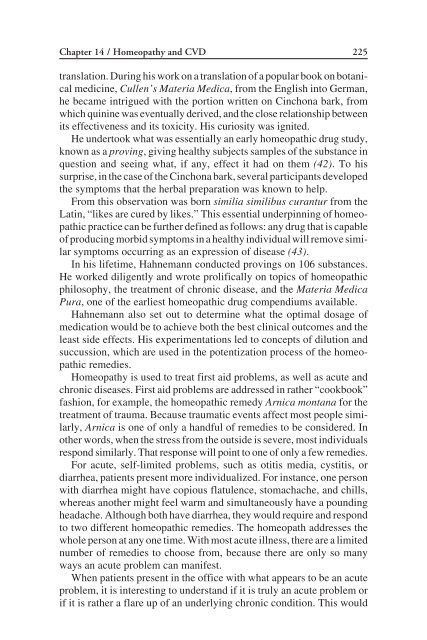Complementary Alternative Cardiovascular Medicine
Complementary Alternative Cardiovascular Medicine
Complementary Alternative Cardiovascular Medicine
You also want an ePaper? Increase the reach of your titles
YUMPU automatically turns print PDFs into web optimized ePapers that Google loves.
Chapter 14 / Homeopathy and CVD 225<br />
translation. During his work on a translation of a popular book on botanical<br />
medicine, Cullen’s Materia Medica, from the English into German,<br />
he became intrigued with the portion written on Cinchona bark, from<br />
which quinine was eventually derived, and the close relationship between<br />
its effectiveness and its toxicity. His curiosity was ignited.<br />
He undertook what was essentially an early homeopathic drug study,<br />
known as a proving, giving healthy subjects samples of the substance in<br />
question and seeing what, if any, effect it had on them (42). To his<br />
surprise, in the case of the Cinchona bark, several participants developed<br />
the symptoms that the herbal preparation was known to help.<br />
From this observation was born similia similibus curantur from the<br />
Latin, “likes are cured by likes.” This essential underpinning of homeopathic<br />
practice can be further defined as follows: any drug that is capable<br />
of producing morbid symptoms in a healthy individual will remove similar<br />
symptoms occurring as an expression of disease (43).<br />
In his lifetime, Hahnemann conducted provings on 106 substances.<br />
He worked diligently and wrote prolifically on topics of homeopathic<br />
philosophy, the treatment of chronic disease, and the Materia Medica<br />
Pura, one of the earliest homeopathic drug compendiums available.<br />
Hahnemann also set out to determine what the optimal dosage of<br />
medication would be to achieve both the best clinical outcomes and the<br />
least side effects. His experimentations led to concepts of dilution and<br />
succussion, which are used in the potentization process of the homeopathic<br />
remedies.<br />
Homeopathy is used to treat first aid problems, as well as acute and<br />
chronic diseases. First aid problems are addressed in rather “cookbook”<br />
fashion, for example, the homeopathic remedy Arnica montana for the<br />
treatment of trauma. Because traumatic events affect most people similarly,<br />
Arnica is one of only a handful of remedies to be considered. In<br />
other words, when the stress from the outside is severe, most individuals<br />
respond similarly. That response will point to one of only a few remedies.<br />
For acute, self-limited problems, such as otitis media, cystitis, or<br />
diarrhea, patients present more individualized. For instance, one person<br />
with diarrhea might have copious flatulence, stomachache, and chills,<br />
whereas another might feel warm and simultaneously have a pounding<br />
headache. Although both have diarrhea, they would require and respond<br />
to two different homeopathic remedies. The homeopath addresses the<br />
whole person at any one time. With most acute illness, there are a limited<br />
number of remedies to choose from, because there are only so many<br />
ways an acute problem can manifest.<br />
When patients present in the office with what appears to be an acute<br />
problem, it is interesting to understand if it is truly an acute problem or<br />
if it is rather a flare up of an underlying chronic condition. This would


